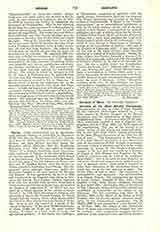

Serrae, titular metropolitan see in Macedonia, more correctly Serrhae, is called Siris by Herodotus (VIII, 115), Sirae by Titus Livius (XLV, iv). Inscriptions show the official spelling to have been Sirrha or Sirrhae; the form Serrhae prevailed during the Byzantine period (Hierocles, 639, 10; Stephanius Byzantius, s.v.). The city, now called in Turkish “Seres”, is in Eastern Macedonia, about forty-three miles northeast of Salonica in the plain of Strymon, on the last outposts of the mountains which bound it on the northeast. On his return to the Hellespont, Xerxes left some of his sick followers at Serrae, and here also P. Aemilius Paulus, after his victory at Pydna, received a deputation from Perseus. The city possessed great strategic importance under the Byzantine Empire in the wars against the Servians and Bulgars. It was captured by the latter in 1206 and recaptured by the Emperor John Dukas in 1245. Later the Servian, Kral Stephen Dushan, captured it in turn, was crowned there in 1345, established a Court on the model of that of Byzantium, and married the daughter of Andronicus II. In 1373 it was captured by a Greek apostate in the service of Sultan Murad I. In 1396, while Sigismund of Hungary was preparing to attack the Ottoman Empire, the Sultan Bayazet had his camp at Seres, where he assembled his Christian allies shortly before the Battle of Nicopohs. Seres is now the capital of a sanjak in the vilayet of Salonica. It has about 30,000 inhabitants, of whom 13,000 are Turks and the same number Greeks. It carries on a brisk trade in textile and agricultural products. At first Serrae was a suffragan of Thessalonica, remaining so probably until the eighth century, when Eastern Illyricum was removed from Roman jurisdiction and attached to the Patriarchate of Constantinople. It figures in the “Notitiae episcopatuum” as an autocephalous archdiocese as early as the tenth century; at the end of the next century it had become a metropolitan see without suffragans, and such is still its status for the Greeks. Le Quien (Oriens Christ., II, 87) gives a list of fourteen bishops, but a much more complete list is given in Papageorgiou’s article cited in the bibliography. The oldest of these bishops is Maximianus or Maximus, present at the Latrocinium of Ephesus (449) and at the Council of Chalcedon (451). A gap intervenes till the end of the tenth century, when Leontius assisted at a council of Constantinople. Among the other titulars was Nicetas, formerly a deacon of St. Sophia, Constantinople, and eventually Metropolitan of Heraclea (Pontus), at the end of the eleventh century. He was a prolific writer [see Krumbacher,”. Gesch. der byzant. Litt.” (Munich, 1897), 137 sqq, 211 sqq, 215 sqq, 587, etc.]. Under Michael Palaeologus, a metropolitan of Serrae whose name is unknown was among the advocates of union with Rome. In 1491 Manasses became Patriarch of Constantinople under the name of Maximus. Eubel, “Hierarchia catholica medii nevi” I, 473, mentions two Latin metropolitans: Arnulphus in 1225 and Pontius in 1358.
S. PETRIDES


